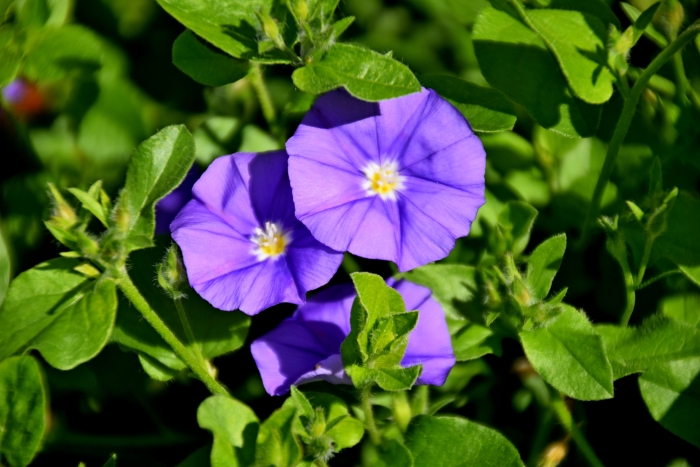Blue Rock Bindweed
(Convolvulus sabatius)
Blue Rock Bindweed (Convolvulus sabatius)
/
/

Krzysztof Golik
CC BY-SA 4.0
Image By:
Krzysztof Golik
Recorded By:
Copyright:
CC BY-SA 4.0
Copyright Notice:
Photo by: Krzysztof Golik | License Type: CC BY-SA 4.0 | License URL: https://creativecommons.org/licenses/by-sa/4.0 | Uploader: Tournasol7 | Publisher: Wikimedia Commons | Title: Convolvulus_sabatius_'Blue_Cascade'_in_Jardin_des_Plantes_de_Toulouse_02.jpg | Notes: Transferred from Flickr via #flickr2commons |









































Estimated Native Range
Summary
Convolvulus sabatius, commonly known as Blue Rock Bindweed, is an evergreen perennial herb that is native to coastal areas, rocky slopes, and scrublands in the Western Mediterranean and North Africa. It typically grows to a modest height of 20 cm (8 in) and features trailing stems that make it suitable for hanging baskets and ground cover. The leaves are slightly hairy, contributing to its textured appearance. Its flowers are light blue to violet, often with a lighter center, and are 2.5–5 cm (1–2 in) in diameter, blooming from late spring to early autumn. The flowers are particularly showy and attract pollinators.
Blue Rock Bindweed is valued for its cascading habit, vibrant flowers, and low maintenance requirements. It is often used in window boxes, containers, and as a ground cover in sunny areas. This plant thrives in well-drained soil and can tolerate drought once established, making it suitable for xeriscaping. Tip pruning encourages bushier growth and more abundant flowering. It has gained the Royal Horticultural Society’s Award of Garden Merit, indicating its exceptional performance in gardens. While it is perennial in its native range, in colder climates, it is often grown as an annual. It can become invasive in some areas, so gardeners should monitor its spread.CC BY-SA 4.0
Blue Rock Bindweed is valued for its cascading habit, vibrant flowers, and low maintenance requirements. It is often used in window boxes, containers, and as a ground cover in sunny areas. This plant thrives in well-drained soil and can tolerate drought once established, making it suitable for xeriscaping. Tip pruning encourages bushier growth and more abundant flowering. It has gained the Royal Horticultural Society’s Award of Garden Merit, indicating its exceptional performance in gardens. While it is perennial in its native range, in colder climates, it is often grown as an annual. It can become invasive in some areas, so gardeners should monitor its spread.CC BY-SA 4.0
Plant Description
- Plant Type: Herb
- Height: 0.4-0.5 feet
- Width: 1-2 feet
- Growth Rate: Moderate
- Flower Color: Blue, Purple
- Flowering Season: Spring, Summer, Fall
- Leaf Retention: Evergreen
Growth Requirements
- Sun: Full Sun, Part Shade
- Water: Low
- Drainage: Medium
Common Uses
Bank Stabilization, Bee Garden, Bird Garden, Border Plant, Butterfly Garden, Deer Resistant, Drought Tolerant, Groundcover, Hummingbird Garden, Low Maintenance, Potted Plant, Rock Garden, Salt Tolerant, Showy Flowers, Street Planting
Natural Habitat
native to coastal areas, rocky slopes, and scrublands in the Western Mediterranean and North Africa
Other Names
Common Names: Ground Blue-Convolvulus , African Bindweed , Ampelvinda
Scientific Names: Convolvulus sabatius
GBIF Accepted Name: Convolvulus sabatius Viv.